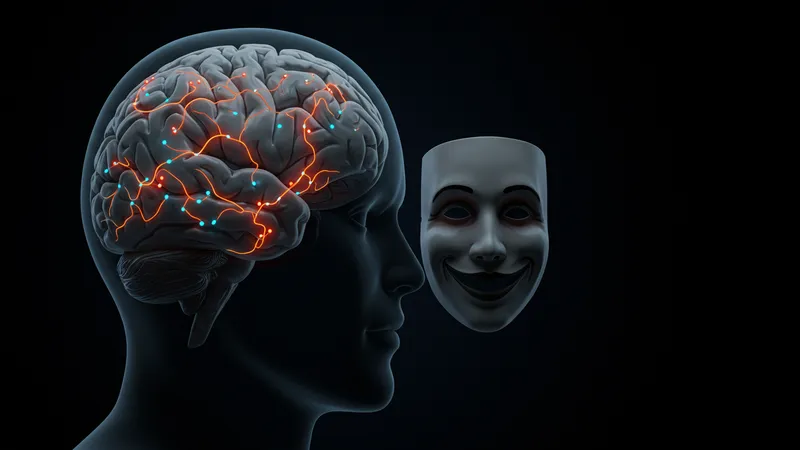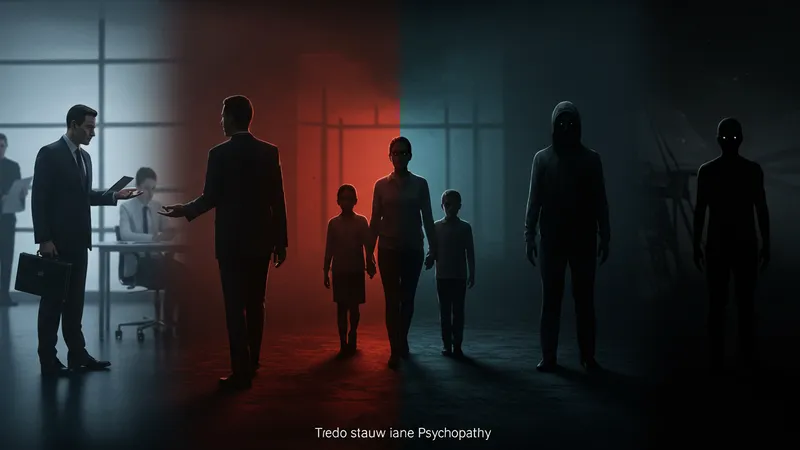Did you know that your seemingly charming neighbor might possess the traits of a psychopath? Recent studies suggest that these individuals are much more common than you'd expect, hiding in plain sight.
In a world where masks are the norm, recognizing a psychopath’s traits is more vital than ever. As they seamlessly blend into society, their chilling characteristics may quietly impact your life.

One astonishing fact is how adept psychopaths are at maintaining composure under pressure. Unlike most, they show no fear or anxiety in stressful situations. This unsettling calmness can make them difficult to detect. But that’s not even the wildest part…
Psychopaths commonly exude charisma and charm, making them likable and respected individuals in society. Their adept manipulation skills allow them to climb social and corporate ladders effortlessly. But there’s more to discover that will leave you questioning everything…
What happens next shocked even the experts. The reality of their presence and influence in our day-to-day lives is unsettling. Discovering their traits could change how you perceive those around you.
Imagine meeting someone who instantly captivates you with their magnetic charm and eloquent speech. This is a signature trait of a psychopath. Often, their charisma is a carefully crafted facade to weave their way into circles of influence. But there’s more beneath the surface that few anticipate: while they easily gain trust, they shun genuine emotional connections. Their relationships are merely transactional.

The allure they possess is not only for personal gain but also serves as a shield to deflect suspicion. Characterized by a superficial charm, they leave people feeling valued and heard. However, this is merely a tool in their toolkit. These interactions often turn manipulative without the other party’s awareness. But there’s one more twist…
Research indicates that this charisma is coupled with a profound lack of empathy. Psychopaths are adept at mimicking emotional responses, creating the illusion of understanding. Yet, the emotional void remains, as they inherently lack the ability to truly sympathize with others’ feelings. This insight is essential for navigating social dynamics with them.
What you read next might change how you see this forever. Their uncanny ability to mimic societal norms extends beyond charm, making them virtually undetectable in some scenarios. The implications of these hidden traits on everyday interactions remain a point of intense study.
Psychopaths remarkably adapt to societal norms, easily blending into workforces and communities. Their public personas can be strikingly ordinary, often thriving in structured environments where rules serve as helpful checks. But it’s their disregard for those same rules under the surface that puzzles researchers.

Such adaptability is both fascinating and terrifying, allowing them to exploit social systems with ease. You might meet them at PTA meetings, or find them coaching your kid's soccer team. Awareness of their sophisticated facade is crucial, as it makes detecting harmful behaviors immensely challenging.
Despite their normal exterior, the veiled intent of psychopaths can stoke destructive tendencies. Their calculated risk-taking and impulsive decisions often go unnoticed, posing unseen threats in professional and personal realms. How they remain undetected will intrigue you further.
But what about the other areas they infiltrate so seamlessly? From boardrooms to local governments, their presence is pervasive. To understand and identify them within these hidden landscapes is crucial—not just for safety, but for maintaining societal balance. The trends likely stay with you long after reading this.
Several subtle red flags can signal psychopathic tendencies, detectable to the trained eye. Their blatant disregard for societal mores manifests in unexpected, often shocking ways. Yet, it’s their uncanny ability to go unnoticed that concerns those studying this behavior.

Look for inconsistencies in their actions versus words. While they may articulate fairness and integrity, their actions often paint a different picture. A recurring pattern of exploiting others under the guise of mutual benefit could be a telling sign.
Additionally, their aptitude for deceit is unparalleled. Lies fuel their ambitions, allowing them to manipulate narratives effortlessly, often leading those around them into fabricated realities for personal gain. This contradiction between appearance and reality continues to astonish experts.
What are the tangible effects of these traits on colleagues, friends, and even family? Recognizing the subtleties in behavior offers a rare glimpse into the psyche of a psychopath, forever altering your perception of everyday interactions. Style and substance fuse, setting a stage many never see unfold.
Psychopaths revel in high-stakes scenarios and calculated risks. Their fearlessness often leads them to pursue risky ventures, seemingly impervious to the typical bounding fears that stunt others. However, what they seek is not thrill but rather control and domination.

This pursuit of control is meticulously masked as ambition or bravery. It facilitates their rise in competitive settings where others might falter. Their audacity to challenge norms can be mistaken for leadership, although the underlying intentions differ vastly.
Often, their calculated risks bear no regard for potential fallout on others, with success and benefit to themselves being the sole priority. From corporate frameworks to personal arenas, their relentless quest for power can disrupt conventional order in remarkable ways.
Their calculated, sometimes ruthless decision-making has the dual ability to simultaneously instill awe and concern. How these traits manifest in decision-driven roles continues to spur debates among specialists, as understanding these dynamics is essential for those wishing to protect against potential harm.
Empathy, or rather the lack thereof, is a core characteristic defining psychopathy. This absence impacts virtually all interpersonal relationships psychopaths engage in. Peers and colleagues may initially be drawn in by their humor and apparent understanding, but this is only a mimicry of genuine empathetic response.

Research highlights that psychopathy affects neurological response systems tied to empathy, rendering them virtually inactive. This differs crucially from other social dysfunctions where empathy might be weakened but present. In the case of psychopaths, it’s an unbridgeable chasm.
This disconnect allows them to engage in activities others would recoil from, without the burden of remorse or emotional consequence. It's this quality that allows them to develop and utilize their manipulative tactics so effectively. The knowledge of this disconcerting trait reveals much about their broader motives.
Examining the depths of this emotional dead zone not only deepens understanding but also raises important questions on detecting and addressing such behaviors in broader society. Emerging insights could lead to evolving social strategies that provide safeguards against undue influence.
Another hallmark of psychopathy is the practice of maintaining dual personas, leading to an existence fraught with internal cognitive dissonance. While they project one image publicly, their private thoughts and behaviors often conflict markedly, revealing a darker self.

These dualities create significant internal conflict, though it does not deter their socially predatory behavior. Rather, it becomes a tool. They embrace moral flexibility with ease, a quality that allows them to justify actions deemed unacceptable by societal standards.
In personal and professional spaces, this capacity for cognitive dissonance enables psychopaths to engage in transactions devoid of moral constraints. The internal justification mechanisms they employ typically manifest in rationalizations that defy the norm.
Analyzing these inconsistencies illuminates the complexity of irrational yet calculated decision-making. This understanding fosters improved predictive models and responses in fields regarding psychopathy, further enhancing societal awareness and intervention techniques.
Not all psychopaths fit the mold of notorious criminals; rather, they exist on a spectrum with varying degrees of traits and tendencies. While some possess subtle characteristics that minimally impact their lives and those around them, others display behaviors with profound implications.

This range explains why certain individuals are able to maintain careers and family lives, overshadowed only by the occasional aberration, while others spiral into antisocial or dangerous territories. Understanding the gradations of this spectrum is key to accurate identification and potential intervention.
Some show traits in professional environments that echo Type A behaviors without the aggressive edge. Yet, the subtle exhibition of manipulation can serve as a red flag to those attuned. Contextualizing these behaviors leads to a nuanced approach in identifying psychopaths.
The categorization attempts to provide clarity within a multifaceted disorder. This exploration poses significant questions around how society perceives and treats individuals on this spectrum, urging a reevaluation of methods used in recognition and understanding of such personality traits.
Underneath the veneer of success, some psychopaths engage in a series of hidden misdeeds that underscore the darker aspects of their character. Despite achieving corporate or social prominence, ethical lapses typically trail their accomplishments, largely unnoticed by the larger population.

Such indiscretions involve exploitation and deceit, often obscured by charm and strategic alliances. These behaviors typically emerge under conditions that jeopardize their authoritative façade, revealing glimpses into their true nature.
These unethical behaviors, from financial manipulation to social betrayal, are often normalized by psychopaths to fit their narrative of success. The ability to rationalize these acts as necessary for achievement marks them distinctly apart from their non-psychopathic counterparts.
Yet, recognizing these patterns unveils a necessary dialogue surrounding ethics, accountability, and the psychology of success. By understanding the undercurrents of psychopathy in such environments, frameworks can be developed to mitigate risks and promote healthier societal values.
The debate over nature versus nurture questions the origins of psychopathy, exploring genetic predispositions and environmental impacts in shaping these personalities. Studies increasingly indicate a complex interplay, suggesting neither genetics nor upbringing alone determines the emergence of these traits.

Environmental influences, such as childhood trauma or exposure to certain behaviors, appear to exacerbate potential psychopathic tendencies in predisposed individuals. Conversely, some may show resilience, escaping the fate many in their circumstance endure.
The understanding of how these dynamics work could revolutionize prevention strategies and early intervention models. While the nature versus nurture debate remains unresolved, it expands our understanding of the myriad factors contributing to psychopathy.
This exploration into their origins not only enriches scientific discourse but expands the scope of practical approaches aimed at preempting the development of psychopathic traits, offering a glimmer of hope in addressing the roots of behavior previously thought immutable.
The legal system grapples with how to best address individuals with psychopathic tendencies. Their understanding of actions combined with diminished emotional responses to consequences poses a unique challenge to traditional judicial procedures.

Typically, the debate centers on culpability. Can we hold someone with psychopathic traits fully responsible for actions they may not emotionally process? This conversation becomes particularly complex in criminal cases where intent and awareness are core concerns.
The prospects of effective reform remain divisive. Programs aimed at rehabilitation or correction often encounter difficulties given the intrinsic resistance found in those with psychopathic traits. Yet, emerging studies in cognitive adaptation present pathways for change.
The intertwining of legal responsibility with psychological insight forces a reassessment of current practices. Structured reform and informed legal approaches offer promise in mitigating the societal impact of psychopathy, suggesting a precautionary role of preventive care and education.
The presence of psychopaths in society introduces notable implications across different domains—economic, social, and cultural. Their ability to manipulatesituations can create ripples that affect not only direct relationships but also broader societal structures.

The normalization of certain behaviors due to psychopathic influence can destabilize historical norms, challenging the foundations of trust and ethical standards. By recognizing and understanding these impacts, society can work toward reinforcing the values at risk.
Moreover, the blurred boundaries between acceptable and reprehensible behavior introduce complexities distinguishing genuine leadership from psychopathic prominence. Corrective measures and heightened awareness serve as tools to address these challenges.
This inquiry into the societal implications necessitates a reevaluation of responses ranging from education to policy. The ripple effects extend further than previously anticipated, redefining the narrative around psychopathic traits and their capacity to influence broader realms.
Prevention and awareness form the cornerstone of strategies aimed at reducing the risks associated with psychopathic individuals. Educational initiatives focused on recognizing warning signs early can play a vital role in mitigation, empowering people with knowledge.

The propagation of information through workshops, seminars, and media serves to demystify psychopathy, fostering a proactive approach to the recognition and management of potential threats maximizes societal safety—a goal worth the collective investment.
Important advances in technology, such as behavioral analytics, provide tools for observation and detection, enabling earlier intervention and tailored defense strategies. Continued research and application of these technologies offer promising avenues for future development.
Harnessing the power of education and technology to promote heightened awareness and prevent the normalization of harmful behaviors reflects societal resilience. By pooling resources and expertise, humanity can forge paths to reduce the presence of psychopathy's shadow in everyday life, striving for a more harmonious future.
In understanding the telltale traits of a psychopath, we unlock doors to broader societal and individual insights. The lessons gleaned urge vigilance in discerning the shadows that walk among us. Armed with awareness, we challenge ourselves to see beyond the mask, transforming fear into informed action. Your role in sharing this knowledge cannot be overstated—pass it on, bookmark for deeper study, and let these insights inspire proactive change.